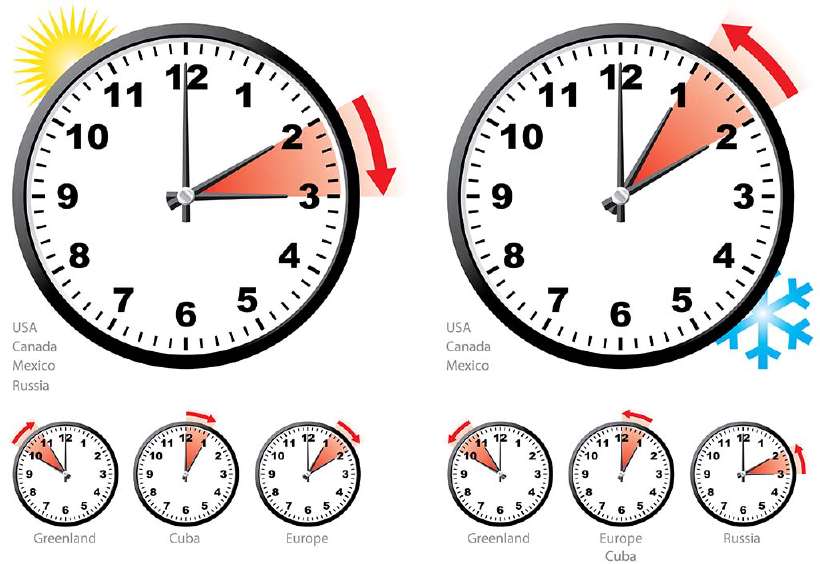What is Daylight Saving Time?
Home / Science for Kids / 5Ws & H For Kids / What is Daylight Saving Time?
People in some parts of the world gain an extra hour in winters and are able to sleep and snore that much longer thanks to a suggestion by Benjamin Franklin about daylight saving time. But when the suggestion was first made, it raised such a furore not only from those kept awake by the extra snoring but also from others and they wasted a lot of time fighting over this extra hour.
Actually the confusion began when the postal service and the railways began to connect far-flung cities. These towns followed their town clock by measuring the position of the sun. Therefore every city was on a slightly different time.
![What is Daylight Saving Time? [Illustration by Anup Singh]](/media/5wh-96_1_hu707c397373fd3cd71d2854296915f8f2_7966_820x0_resize_q60_box.gif)
In 1784, Benjamin Franklin, who was US ambassador to France then, suggested the daylight saving time concept but he was ignored. However, the railways decided to standardise time and Britain was the first to adapt a single consistent time across the country. But, this did nothing to ease international travel.
In 1884, a Canadian railway engineer Sir Sanford Fleming suggested that the entire world be divided into time zones that would be calculated from a prime meridian. This would help calculate various time zones relative to that one.
In October 1884, the International Meridian Conference met in Washington, DC and chose Greenwich, a village just outside London in England as the prime meridian. Though this Greenwich Meridian Time (GMT) was approved and adopted by the world, the various time zones across the world caused longer daylight hours in summer and shorter daylight hours in winter in certain countries.

So in 1907, a Londoner called William Willett tried to revive the subject of daylight savings time. Unfortunately he got laughed at. It was the practical Germans who realized that such a scheme helped reduce energy costs in lighting and electricity and immediately implemented it.
But why would you want to save daylight time at all? Adopting the Daylight Saving Time (DST) scheme saves energy. Energy used and the demand for electricity for lighting our homes is directly connected to when we go to bed and when we get up.
Studies show that sunrise in the summer is very early and most people wake up after the sun rises. Because the sun is up, we don’t need to turn on lights in our homes. Thus, we actually use less energy in the morning. The opposite works in winter.
With DST, the ‘spring forward and fall (autumn) backward’ system comes into play. In summer, the clock is extended by an hour and the sun therefore ‘sets’ one hour later. This means that less electricity would be used for lighting and appliances later in the day. In autumn and winters, the clock is set an hour backward as more light is needed in the morning.
However, there was opposition as people did not like the idea of getting up an hour early or going to bed an hour later, just to keep up with the Joneses in some far off village in Greenwich.
Others complained of the inconvenience of changing all the clocks, and adjusting to a new sleeping schedule. For most people, this is a mere nuisance, but for some people with sleep disorders this transition is very difficult.
But in 1916, a year after Willett died, Britain and USA adapted DST. Other countries followed suit. The motivation was to conserve coal during World War I. Clocks were put one hour ahead of GMT during the summer months. But in 1918 the law was repealed in the United States.
Two decades later during World War II, DST was re-introduced to help the war effort and clocks were put two hours ahead of GMT during summer! This became known as Double Summer Time.
From 1945 to 1962, DST became quite inconsistent with a hodgepodge of time observances and no agreement when to change clocks. Countries were free to observe or not observe DST. This caused confusion no end – especially for the broadcasting industry, for the postal service, railways and airlines.
In 1966, the United States Congress introduced the Uniform Time Act to regulate DST across the country. Today, approximately 70 countries utilize DST. While Europe has been taking advantage of the time change for decades, in 1996 the European Union (or EU) standardized a EU-wide ‘summertime period’. The EU is the union of all European countries into one economic entity, though they differ politically.
However, some countries like those in the equatorial and tropical regions do not observer DST as daylight hours are similar through the year and there is no advantage in moving clocks backward and forwards.
779 words |
7 minutes
Readability:
Grade 8 (13-14 year old children)
Based on Flesch–Kincaid readability scores
Filed under: 5ws and h
Tags: #clocks, #electricity, #greenwich, #meridian
You may also be interested in these:
Protest Without Clothes